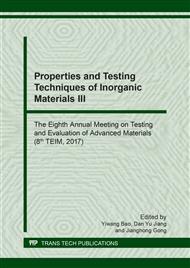[1]
Y. Liu, F.F. Min, J.B. Zhu, et al., Mater. Sci. Eng. A 546 (2012) 328–331.
Google Scholar
[2]
W. Pabst, E. Gregorová, M. Černý, J. Eur. Ceram. Soc. 33 (2013) 3085-3093.
Google Scholar
[3]
S. Puchegger, F. Dose F, D. Loidl, et al., J. Eur. Ceram. Soc. 27 (2007) 35-39.
Google Scholar
[4]
W. Pabst, E. Gregorová, In: Caruta B.M. editor, New developments in materials science research, Nova Science Publishers, New York, 2007, p.77–137.
Google Scholar
[5]
J. Werner, J. Fruhstorfer, A. Mertke, et al., Ceram. Int. 42 (2016) 15718-15724.
Google Scholar
[6]
D. Hasselman, J. Am. Ceram. Soc. 52 (1969) 600-604.
Google Scholar
[7]
Y. Joliff, J. Absi, M. Huger, et al., Comput. Mater. Sci. 44 (2008) 826-831.
Google Scholar
[8]
A.P. Luz, T. Santos Jr., J. Medeiros, et al., Ceram. Int. 39 (2013) 6189-6197.
Google Scholar
[9]
J. Werner, C.G. Aneziris, S. Dudczig, J. Am. Ceram. Soc. 96 (2013) 2958–2965.
Google Scholar
[10]
B. Qi, J. Absi, N. Tessier-Doyen, Comput. Mater. Sci. 46 (2009) 996-1001.
Google Scholar
[11]
ASTM C674-13, Standard Test Method for Flexural Properties of Ceramic Whiteware Materials, (2013).
Google Scholar
[12]
GB/T 10700-2006, Test methods for elastic moduli of fine ceramics (advanced ceramics, advanced technical ceramics) — Bending method, (2006).
DOI: 10.3403/30325697u
Google Scholar
[13]
ASTM C623-92, Standard Test Method for Young's Modulus, Shear Modulus, and Poisson's Ratio for Glass and Glass-Ceramics by Resonance, (2015).
DOI: 10.1520/c0623
Google Scholar
[14]
ASTM C1548-02, Standard Test Method for Dynamic Young's Modulus, Shear Modulus, and Poisson's Ratio of Refractory Materials by Impulse Excitation of Vibration, (2012).
DOI: 10.1520/c1548-02r07
Google Scholar
[15]
ASTM C1259-15, Standard Test Method for Dynamic Young's Modulus, Shear Modulus, and Poisson's Ratio for Advanced Ceramics by Impulse Excitation of Vibration, (2015).
DOI: 10.1520/c1259-21
Google Scholar
[16]
E. Nonnet, N. Lequeux, P. Boch, J. Eur. Ceram. Soc. 19 (1999) 1575-1583.
Google Scholar
[17]
E.W. Neuman, G.E. Hilmas, W.G. Fahrenholtz, J. Eur. Ceram. Soc. 35 (2015) 463-476.
Google Scholar
[18]
G.D. Girolamo, F.Marra, C. Blasi, et al., Ceram. Int. 40 (2014) 11433-11436.
Google Scholar
[19]
Z. Liu, Y.W. Bao, D.T. Wan, et al., Ceram. Int. 41 (2015) 12835–12840.
Google Scholar
[20]
ASTM E1875-13, Standard Test Method for Dynamic Young's Modulus, Shear Modulus, and Poisson's Ratio by Sonic Resonance, (2014).
DOI: 10.1520/e1875-00e01
Google Scholar
[21]
Y.W. Bao, Y.C. Zhou, X.X. Bu, et al., Mater. Sci. Eng. A 458 (2007) 268-274.
Google Scholar
[22]
F.P. Beer, E.R. Johnston, J.T. Dewolf, et al., Mechanics of Materials, 6th ed., McGraw–Hill, (2012).
Google Scholar
[23]
D.T. Wan, Y.W. Bao, X.G. Liu, et al., Adv. Mater. Res. 177 (2011) 114-117.
Google Scholar
[24]
E.W. Neuman, G.E. Hilmas, W.G. Fahrenholtz, J. Eur. Ceram. Soc. 33 (2013) 2889-2899.
Google Scholar
[25]
J.B. Wachtman, D.G. Lam, J. Am. Ceram. Soc. 42 (1959) 254–260.
Google Scholar
[26]
A. Hauert, A. Rossoll, A. Mortensen, Compos. Part A 40 (2009) 524-529.
Google Scholar
[27]
O. Bahr, P. Schaumann, B. Bollen, et al., Mat. Des. 45 (2013) 421-429.
Google Scholar
[28]
M. Alfano, L. Pagnotta, G. Stigliano, et al., 3rd WSEAS International Conference on Applied and Theoretical Mechanics, Dec 2007, Tenerife, pp.14-16.
Google Scholar
[29]
A.P. Luz, M. Huger, V.C. Pandolfelli, Ceram. Int. 37 (2011) 2335-2345.
Google Scholar


